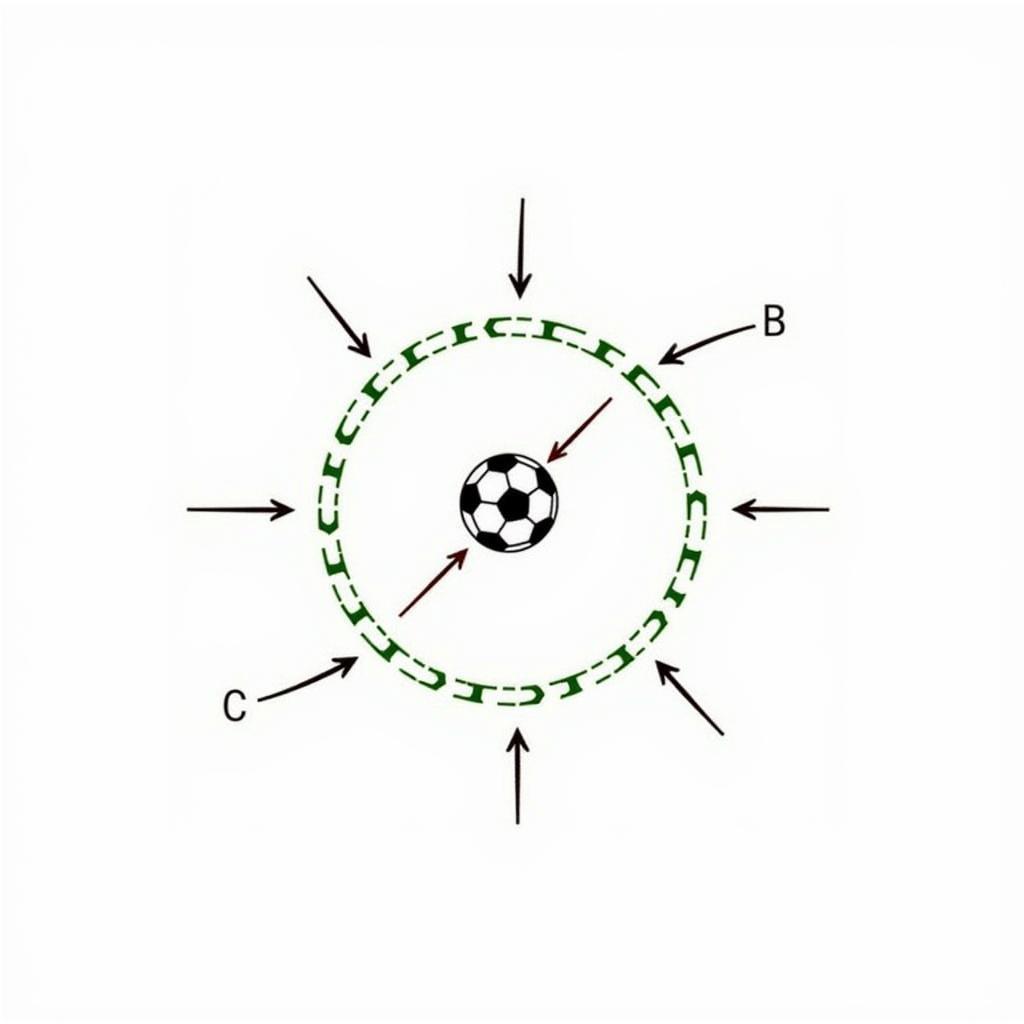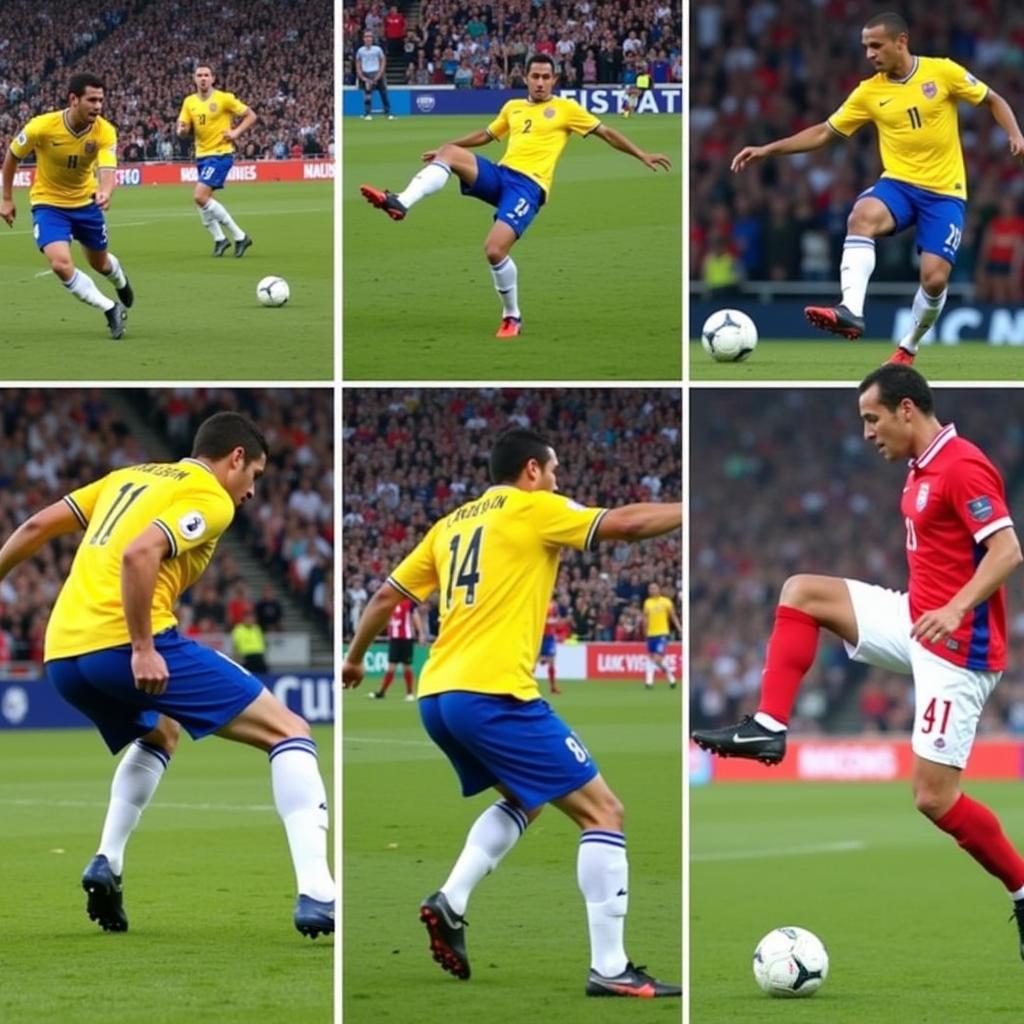Hydro Bats: The Science Behind the Swerve
October 21, 2024The beautiful game is full of moments that take your breath away. A perfectly placed pass, a stunning volley, a mazy dribble – these are the things that make football so special. But have you ever stopped to think about the science behind these moments of magic?
Take the “hydro bat,” for example. This fascinating phenomenon occurs when a football player strikes the ball with such precision and power that it seems to defy the laws of physics. The ball dips and swerves in the air, leaving the goalkeeper stranded and the fans in awe.
 Footballer taking a free kick that results in a hydro bat
Footballer taking a free kick that results in a hydro bat
What Causes a Hydro Bat?
While it might look like magic, the hydro bat is actually the result of a perfect storm of physics and athleticism. Here’s a breakdown of the key factors:
-
The Magnus Effect: When a spinning ball travels through the air, it creates a vortex of air around itself. This vortex interacts with the airflow around the ball, creating pressure differences. The side of the ball spinning into the airflow experiences lower pressure, while the side spinning with the airflow experiences higher pressure. This pressure difference generates a force perpendicular to the ball’s direction of motion, causing it to curve or bend.
-
The Role of Moisture: Here’s where things get really interesting. The presence of moisture on the surface of the ball, even a thin layer of condensation, can amplify the Magnus Effect. This is because the moisture creates a rougher surface, increasing the friction between the ball and the air. This increased friction enhances the pressure differential and leads to a more pronounced curve.
-
The Kicking Technique: Of course, none of this matters without the right technique. To execute a hydro bat, a player needs to strike the ball with both power and precision, using the inside of their foot to generate spin. The point of contact with the ball is crucial; hitting slightly below the center of the ball will cause it to spin backwards, leading to the dipping, swerving trajectory.
 Diagram illustrating the Magnus Effect on a spinning football
Diagram illustrating the Magnus Effect on a spinning football
The Art of Mastering the Hydro Bat
Mastering the hydro bat takes an incredible amount of skill and practice. Here are some insights from my own experience:
-
Practice Makes Perfect: It’s all about repetition. Countless hours on the training ground, experimenting with different striking techniques, ball contact points, and power levels, are essential for developing the muscle memory needed to execute this technique consistently.
-
Understanding the Conditions: The weather can play a significant role in the hydro bat. Humid conditions or a light drizzle can enhance the effect, while dry conditions might require adjustments to the kicking technique.
-
The Element of Surprise: The hydro bat is most effective when it’s unexpected. Catching the goalkeeper off guard is key to maximizing the chances of scoring.
Hydro Bats in Football History
Throughout football history, there have been countless examples of spectacular Hydro Bats that have left fans speechless.
Roberto Carlos’s free-kick against France in 1997 is often cited as one of the most iconic examples of this phenomenon. The Brazilian legend unleashed a thunderbolt of a shot that seemed to defy physics, bending around the French wall and leaving the goalkeeper completely helpless.
 Roberto Carlos taking his famous free kick against France
Roberto Carlos taking his famous free kick against France
Conclusion
The hydro bat is a testament to the beautiful complexity of football. It’s a reminder that even in a game of inches, there’s always room for artistry, science, and a little bit of magic.
So, the next time you see a ball dip and swerve in a way that seems impossible, remember the hydro bat. It’s a reminder that anything is possible with the right combination of skill, knowledge, and a little help from the laws of physics.
FAQs
1. Can any player execute a hydro bat?
While theoretically any player can learn the technique, it requires a high level of skill and practice. Not everyone can achieve the precision and power needed to generate the necessary spin and force for a successful hydro bat.
2. What type of ball is best for a hydro bat?
Modern footballs with smoother, more aerodynamic surfaces might make achieving a hydro bat slightly more challenging compared to older, leather balls. However, with the right technique, it’s still possible to generate the effect.
3. Does the altitude affect a hydro bat?
Yes, the altitude can play a role. At higher altitudes, the air is thinner, which can result in less air resistance and a less pronounced curve. Players might need to adjust their technique accordingly.
4. Is the hydro bat only effective for free kicks?
While it’s commonly seen in free kicks, the hydro bat can be applied to other situations as well, such as corners or even open play shots, as long as the player can generate the right spin and power.
For any assistance, feel free to reach out to us.
Phone: 0963418788
Email: [email protected]
Address: 2M4H+PMH, Phường Nghĩa Thành, Gia Nghĩa, Đắk Nông, Việt Nam.
Our customer service team is available 24/7.